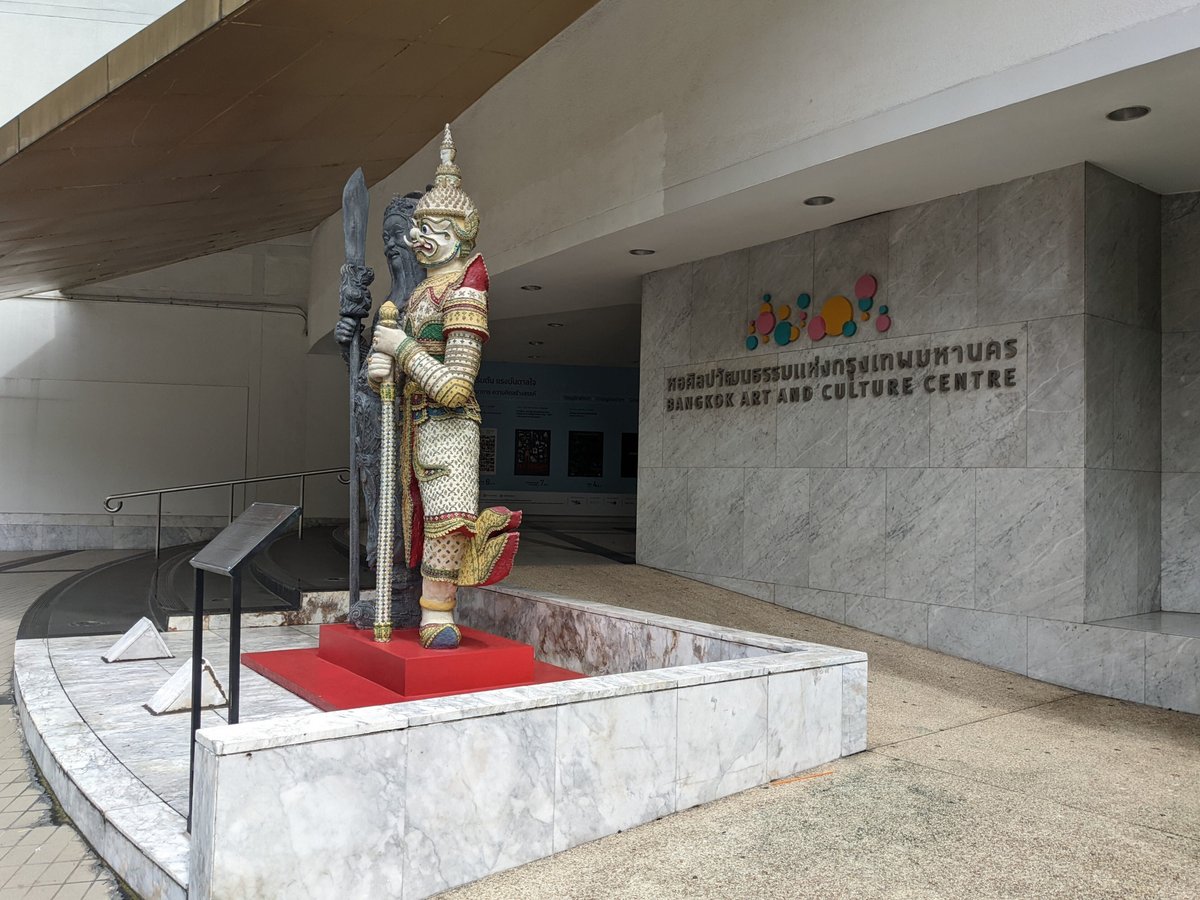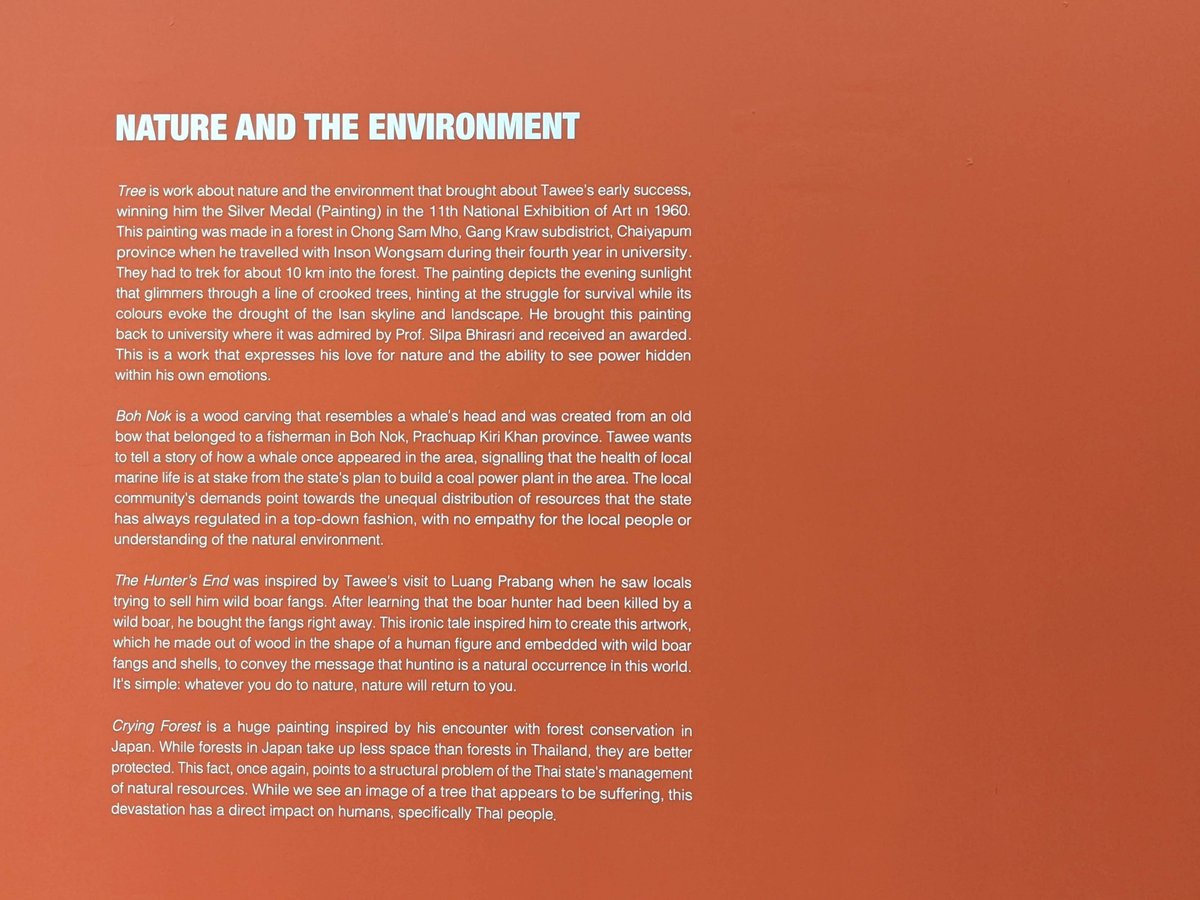
私たちが、アートから学ぶこととは@BACC (Bangkok Art and Culture Centre)
数年ぶりの、タイのバンコクの街は『商業主義』を徹底的に集約した場所のように感じた。日本語が溢れる歓楽街。大型ショッピングセンターが、コンビニのように立ち並ぶ。道を歩いていて、なぜかフランス語で話しかけられることもあった。あの人にとって、フランス語が、唯一話せる外国語なのだろうか。

ベトナムのホーチミンから、飛行機で1時間10分ほどの距離なのに、やたら物価が高くなった気がした。円安の状況で、ATMの手数料もやたら高い。路上でお金を求める人々もいる。路面店での食事以外は、ショッピングセンター内の高級飲食店になる。ビジネス街は、昼間の時間帯の飲食店はどこも人で混みあう。そして、昼休みが終わったら、みな、そそくさとオフィスへ戻っていくのだ。スカイラインの車両は、やたら冷房が効いていて寒い。17度くらいだと思う。


ベトナムのホーチミンがより発展したら、このバンコクの街のようになるのだろうか?家族経営のお店が減って、車や電車でオフィスに向かって、夜遅くまで働いて、コンビニで食事を済ます。そして、バンコクの街が、より発展したら、シンガポールのようになるのだろうか?そうして、シンガポールの友人たちが言う「ここは物価が高すぎて住めないから、海外に行きたい」と言うのだろうか?それぞれの社会には、それぞれの発展過程があって、魅力があって、他の国々から学びながら(反面教師としても)、皆、試行錯誤だ。
アートは、いつの時代も経済発展をする過程でなかなか評価されにくいけれど、それでも、バンコクの『商業主義』を痛感する中でも、少しずつアートにとって生きやすい時代になっているのかなとも思う。で、こんどは街中のカフェのデザインとかすごく「映える」ように表向きだけ飾っているものもよく見かけて、こんどは、人間が教養を学ばないといけないな、という循環。そのような社会の中で、「古くて、新しい」ものには、とても魅力を感じる。
そんなことを考え始めたきかっけは、バンコク初日に雑誌で見つけたタイのアート専門家へのインタビュー記事だった。

"As I grow older, I began to love older paintings. I'm fascinated with certain historial topics, so every time I went on a journey, I found out more about the things that I thought I knew."
「年を取るにつれて、歴史ある絵画を好きになるようになった。いくつかの歴史的な話題に魅了されて、自分が知っていると思っていたことでも、歴史的絵画を見ると、より新しいことを知る感覚」これは、絵画を含む文化もそうで、受け手の受け取り方によっても、文化は変化するものだと思っている。
”I actually think that this is the best period for art, but not the period of the best art. Is there any other period with the best art. Just think. Is there any other period that the Ministry of Culture is willing to support art financially? Is there any other period that you can openly criticize the government and won't be severely punished for it? Is there any other period with more curators being born and more contemporary art being produced? Any other period with this many spaces being created and able to realistically run? Any other period with this developed market structure? All of these are the factors.”
「今の時代は、アートにとって、最適な時代だと思う。でも、最高のアートの時代ではない」文化省が、これほどまでにアートに対して予算を出す時代があっただろうか。
「観光」というものが、「文化」と「スポーツ」と共に、一国の観光省や観光局に脚光を浴びるようになったのも、「持続可能な観光開発」と言われるようになったのも、実は最近のことのように感じる。そして、人々の個人的な交流が、世界の「持続可能な観光開発」や「平和」に貢献することを実感している。
そして、バンコクのアートシーンを探検しに、この雑誌で紹介されていた Bangkok Art and Culture Centre (BACC) へ。

ここは、9階建てのアートセンターで、おもな展示物は9階~7階にあり、6階以下はカフェや文房具屋、本屋、ワークショップスペース等がある。入館料は無料。
”BACC is the historical evidence of the long battle of the masses who call for art spaces in the city.”
まずは、エレベーターで9階から。全体的に、無機質な、白を基調としたスペース。訪れた際は誰もいなかったので、この広々とした空間にいる静寂と瞬間も楽しんだ。





そして、スロープを1階分下がり、8階へ。この階は、壁が濃い緑色に変わる。




"In the past 3 years (2020- 2022), the Bangkok Art and Culture Centre has been focusing on environmental, urban, and behavioural change, which are the core essences of the centure. The exhibitions concentrate on finding equilibrium between man and nature, utilisation of raw materials in the context of digital society with the growing role of artificail intelligence, and building knowledge and awareness of issues that arise from environmental changes caused by the exploitation of natural resources by humans leading to a way of living in harmony with nature, as well as developing mutual respect through contemporary art and cultural activities, which were organised under fluctuating situations in the midst of the COVID-19 pandemic."
過去3年間、BACCは、環境、都市、行動変化に焦点をあててきた。ー「人間と自然の均衡」というものは、あるのだろうか?人間も自然の一部ではないか。
デジタル社会における、原材料の活用。過剰な天然資源の搾取による環境の変化に対する知識の構築と課題への気づき。そして、自然との共生、現代アートと文化に対する敬意。

Tawee Ratchaneekorn 1960 - 2022 A Retrospective Exhibition
もう1階下がって、8階へ。ここの、Tawee氏の絵画の企画がとりわけ印象的で、「グローバライゼーション」「商業主義」「近代文化」の交差点をうまく訴えていた。


GLOBALIZATION, CONSUMERISM, TEMPORARY CULTURE
"Tawee's works from 1990 - 2010 continue to be vocal about the changing world, particularly at a time when liberalism and socialism collided, and capitalism drove us into the consumerist age with the promise of a more equitable society. However, a world connected by the same information reduces human lives to commodities in the global free market and permits large corporations to monopolise. People are still struggling as the state reinforces its control through the patronage system. Furthermore, capitalism is a dessert for the greedy, resulting in the century's major financial crisis. The Tom Yam Koong crises, the baht inflation, and the arrival of IMF's financial regulation. Tawee observes how Thailand remains under the claws of U.S. imperialism, no different to how the region was previously used to persecute communists. He created a series of works that address the contemporary culture of capitalism and consumerism. When we are determined to consume anything, we are already consumed by the cycle - just like the symbol of the embryo born out of the industrial system, struggling to survive while being eaten alive."
「資本主義」は、より公平な社会を約束して、私たちを「消費主義」の時代へと駆り立てた。同じ情報で繋がる社会というものは、世界の自由市場のもとで人々の生活が商品化され、巨大企業の独占を許す。
資本主義は貪欲の砂漠であり、その結果、大規模な金融危機がもたらされた。ーTawee氏は、タイがいかにアメリカ帝国主義の傘下に置かれているかを洞察し、この地域がかつて共産主義者を迫害するために利用されていた方法と何ら変わらないことを訴えるため、資本主義や消費主義をテーマに作品を描く。ー私たちが何かを消費すると決めたとき、私たちはすでに社会のサイクルによって消費されているのだ。



"Whatever you do to the nature, nature will return to you."
"Crying Forest is a huge painting inspired by his encounter with forest conservation in Japan. While forests in Japan take up less space than forests in Thailand, they are better protected. This fact, once again, points to a structural problem of the Thai state's management of natural resources. While we see an image of a tree that appears to be suffering, this devastation has a direct impact on humans, specifically Thai people."

アーティストであるTawee氏は、ラオスのルアンパバーンでの物語や日本の環境保護に影響を受けて、人間と自然との共生、均衡の必要性を訴える。
人生はいつもシンプルで、「私たち人間が自然に対してすることを、自然は返してくるのだ」と。

"His search for a personal signature, expression of inner thoughts, and individuality is similar to that of his Impressionism, Formalism, and Expressionism contemporaries. What sets him apart from others is how he uses these forms to tell contemporary stories rather than making art for art's sake or beauty's sake. Rather, his visual elements mirror life and society, as well as ever-changing current events. Furthermore, his dark humour differentiates his works from those of other Thai artists during his time. - When we look at his ouvre, we can see a combination of artistic languages between that of the aesthetic conventions of modern art and the satirical, critical, and humorous elements of post-modern art."
「皮肉なユーモア」をアートで表現するというのは、ときに政治以上に物を言うものだと思う。Tawee氏の絵画は、人間の欲望と闇を巧みに描き出していて、どこか見る者の心を揺るがせる気がしている。

新しい街で、美術館に行く。図書館にも足を運ぶ。とてつもない量のインプットと写真と共に、満足する。学んだ気になる。けれど、今回、写真を撮りながら、説明文を読みながら、これらの絵画は、私たちが継続して考え続けなければならない課題だと感じた。過去を悔やんでも仕方がない。未来に希望を抱くだけでは、何も解決しない。社会も文化も変わる。
自分自身も国を越えながら、移動しながら、ある瞬間に異なる国の異なる地域の出来事を重ね合わせながら、私たち人間が守りたいものと向かいたい未来は同じだと信じながら、アートを通して課題と向き合う。
創造の場所であるカフェ代のサポートを頂けると嬉しいです! 旅先で出会った料理、カフェ、空間、建築、熱帯植物を紹介していきます。 感性=知識×経験 மிக்க நன்றி
